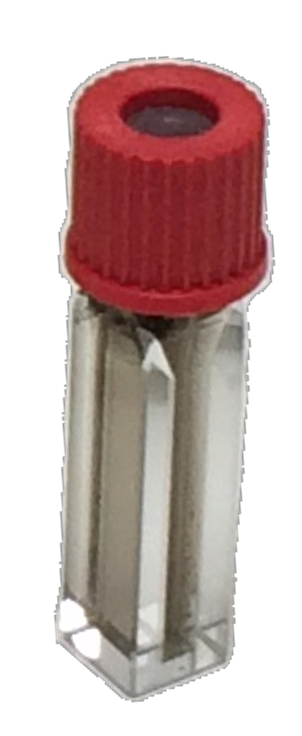Application Note 1: Protocol for Preparing a Dispersion of SWCNT for Fluorimetric Analysis
Sample Preparation
Because SWCNT fluorescence is strongly suppressed by nanotube aggregation, fluorescing SWCNT samples must be prepared using effective dispersion procedures. Each laboratory should develop its own standard protocols appropriate for its range of samples and analytical needs.
In one recommended sample preparation method, a few micrograms of solid SWCNT is placed in a small glass vial to which are added several mL of a surfactant solution in D2O. Sodium dodecylsulfate (SDS), sodium dodecylbenzenesulfonate (SDBS), sodium cholate (SC), and sodium deoxycholate (SDOC) are common recommended surfactants. Brief agitation using an immersion-tip ultrasonic liquid processor (such as the Misonix XL2000) should then give a gray homogeneous suspension. For some cationic surfactants (especially SDS), one drop of 1 M NaOH should be added to ensure high and stable fluorescence intensities. The sample’s emission efficiency may be improved, if desired, by centrifugation to remove dense impurities and some nanotube bundles.
- Prepare a 1% by weight solution of SDBS (sodium dodecylbenzenesulfonate) in DI H2O or in D2O. (Use D2O to make spectral measurements at wavelengths beyond 1350 nm, where H2O begins to absorb strongly).
- In a small glass container (such as a scintillation vial), add ~10 micrograms of raw solild SWCNT material per mL of SDBS solution. (the quantity of SWCNT is not at all critical)
- Using a immersion tip ultrasonicator (with ~3 mm diameter tip), agitate the mixture at a power level of ~5 to 10 W. Place a water or ice bath around the container to prevent excessive heating. Optimal sonication time will vary with the type of sample and application. The liquid should begin to turn gray within seconds as nanotubes disperse, and it should continue to darken as the dispersion process continues. Excessive sonication may cause undesired shortening and/or damage to nanotubes.
- After dispersion, add a drop of NaOH solution to prevent acid-quenching of the SWCNT fluorescence. Fluorescence should be readily measurable from the sample at this point.
- Undispersed solids or visible small particles may remain after ultrasonic treatment. If their removal is desired, the sample can be subjected to moderate centrifugation at ~10,000 x g. This should give a supernatant layer free of visible particles.
- Note that oxidative or acid treatments of the SWCNT material are likely to cause sidewall chemical reactions that will permanently suppress SWCNT near-IR fluorescence. The most strongly emissive samples will be prepared from pristine, “unpurified” nanotube material.
|
The NS3 provides unusual sensitivity for near-infrared emission. With high quality samples, it can record very good fluorescence spectra even from suspensions that appear perfectly clear to the eye. Fluorescent spectra have been acquired at ANF on samples with optical density of only 0.00001 (10-5) at the excitation wavelength. SWCNT-containing films or thin liquid samples with thickness down to a few micrometers may also be used in the fluorescence measurements (special cells or sample holder adapters are required). |
 |


